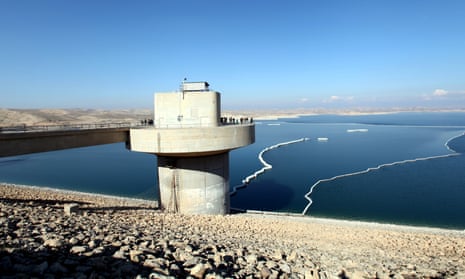The Iraqi government and the US embassy in Baghdad have both issued urgent warnings about the possibility of the Mosul dam collapsing and sending a 20-metre-high flash flood coursing down the river Tigris, putting more than a million people at risk.
The embassy on Monday issued a call for people to evacuate the Tigris flood plain, saying “proper preparation could save many lives”. The embassy had earlier described the threat of collapse as “serious and unprecedented”.
Iraq’s prime minister, Haider al-Abadi, issued a statement on Sunday night urging residents of Mosul, Iraq’s second biggest city, 25 miles south of the dam, to move at least 3.5 miles away from the river. The strength of the warning marked a sharp change in tone for the Baghdad government, which for years has played down the threat of collapse.
The cities of Tikrit, Samarra and Baghdad itself also lie in the path of a potential flood wave.
The dam, the largest in Iraq, has had structural problems since its construction in the 1980s. The Saddam Hussein regime pressed on with it in the face of warnings from geologists that it was being built on weak, water-soluble rock such as gypsum and anhydrite.
A report by a panel of Iraqi and Swedish geologists and engineers last year described it as “the most dangerous dam in the world”, saying its very construction was a “mystery” in view of the unfavourable geology. Before it was built, the report said, “all the studies expressed a clear concern on the fact that this region suffers from extensive presence of soluble rock formations that might undermine the safety of a high dam of a large reservoir such as Mosul dam.”
Since its construction it has been propped up with constant patching with concrete grout, but that maintenance was interrupted when Islamic State extremists temporarily captured the structure in 2014. Water has continued to seep through since then, further weakening the dam. The level of the reservoir has been lowered in an effort to reduce the pressure, but at the expense of irrigation and the potential for power generation.
This month the Iraqi government awarded a contract to an Italian firm, Trevi, for the repair and maintenance of the dam, though Trevi executives said it might be weeks before the deal was finally signed. On Monday a company spokesman confirmed it still had not been signed and gave no expected signature date. The US and Iraqi warnings signal growing concern that the dam could collapse before the Italian-led repair work begins.
The message issued by the US embassy to American citizens said: “Some models estimate that Mosul could be inundated by as much as 70ft (21 metres) of water within hours of the breach. Downriver cities such as Tikrit, Samarra and Baghdad could be inundated with smaller but still significant levels of flooding within 24-72 hours of the breach.
“We have no specific information that indicates when a breach might occur, but out of an abundance of caution we would like to underscore that prompt evacuation offers the most effective tool to save lives of the hundreds of thousands of people living in the most dangerous part of the flood path in the event of a breach.”
